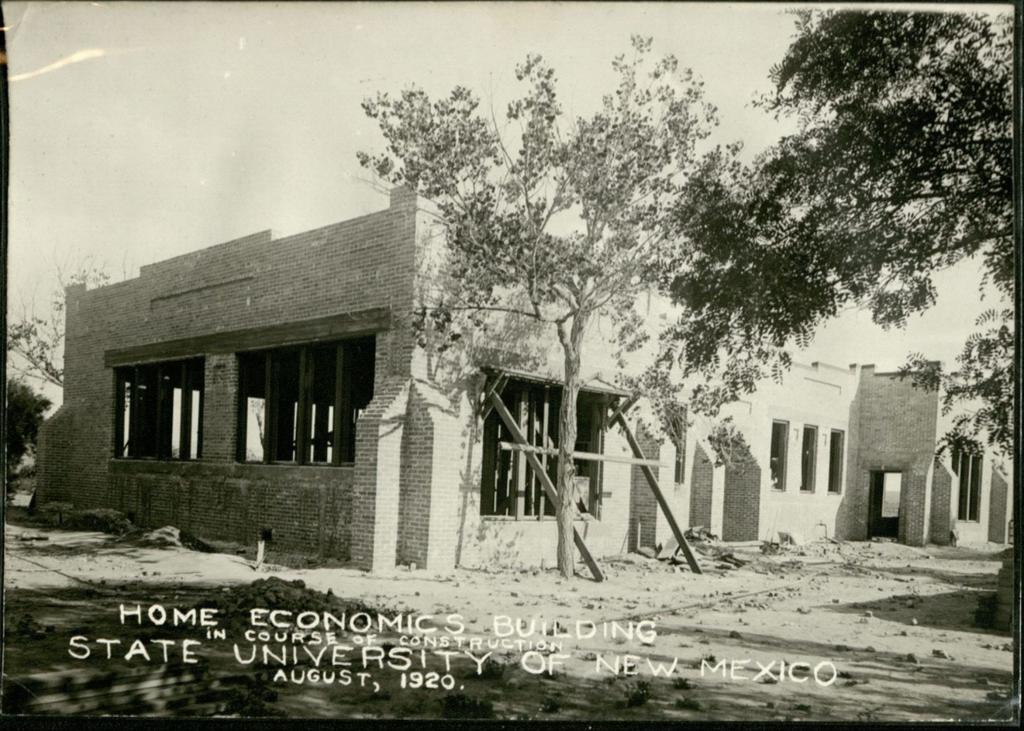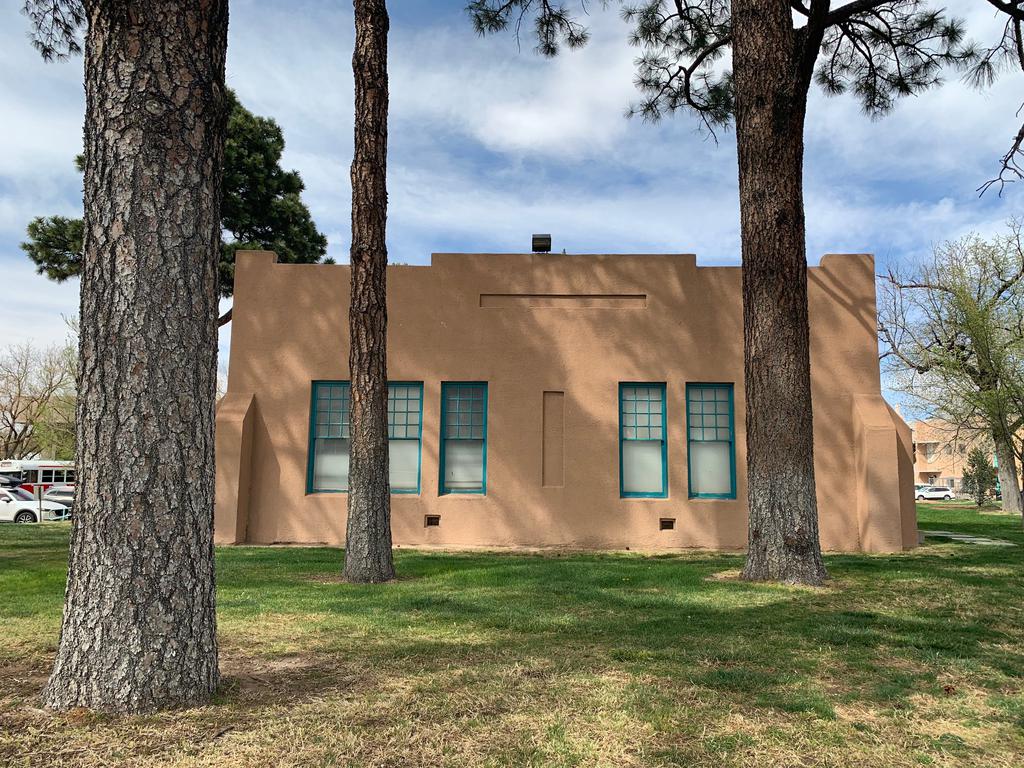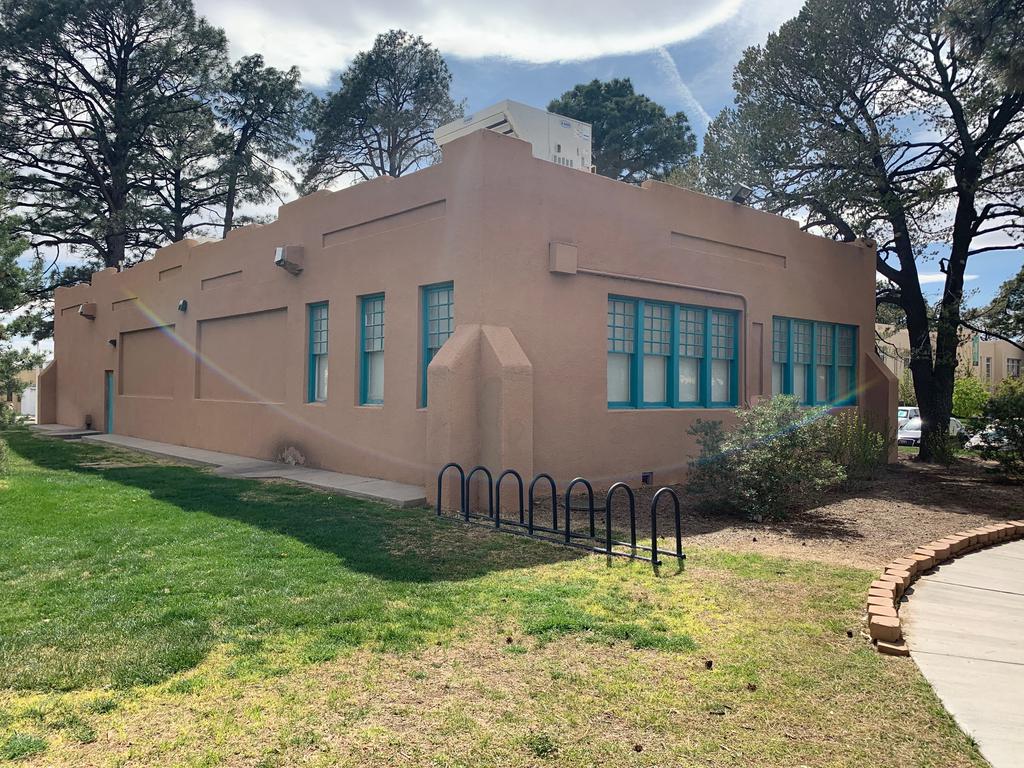Sara Raynolds Hall

Imagine: It’s 1920. The Great War had just ended. The men are coming back home and the women want more to do. A brand new building, Sara Raynolds Hall, is under construction on Central Avenue. It will house the expanding Home Economics Department, opening its doors for women throughout the community.
Overview
Sara Raynolds Hall is a single-story Mayan Pueblo Revival building located at the southern edge of the main campus of the University of New Mexico. It sits on a small rise just north of Central Avenue, with its front facade facing west to Terrance Street. It is a U-shaped brick and stucco building with 12-over-1 double hung wood windows and exaggerated, geometric buttresses on the exterior corners of the building. Built to house the Home Economics Department (which had been working out of the basement of Hodgin Hall until then), it is today in need of some preservation and repair. For example, nearly half of the original windows are missing and have been covered with stucco. Despite this unfortunate neglect, it is incredibly charming, a quintessential representation of early Pueblo Revival institutional buildings. The hall is surrounded by Parson’s Grove, a Romanitic Landscape from 1928 named after early UNM Financial Secretary Josephine Parsons, who served from 1894-1927. The landscape includes several dozen evergreens including the largest cedar on campus. The building and site reflect turn-of-the-century themes such as Romanticism, the expanding roles of women in society, and a growing interest in the science of food.
Early History
Built in 1920, at a cost of $15,720, Sara Raynolds Hall was designed by Albuquerque’s first architect, Edward Buxton Christy (1860-1934) and professor Arno Leupold. It is one of a handful of buildings on campus to be on the National Register of Historic Places. Dedicated on Mother’s Day of 1920, the building was named after the mother of one of its biggest financial contributors, Joshua Raynolds, a local businessman. Although I could find no records of what early classes were taught here, typical Home Economics courses during this period emphasized a scientific and economic approach to childrearing, homemaking, and domestic skills. It is easy to envision Home Economics as just another institutional effort to reinforce traditional sex roles, but the history of this field is more complex and has direct ties to the increased literacy and employability of women and the suffrage movement.





The Depression Years
Correspondence between UNM and The Works Progress Administration reveals the history of a restoration of the building beginning in 1939. It appears that federal government granted UNM $39, 786 for additions to and improvements upon the Home Economics building. The funds were allocated as a non-federal project of the WPA for renovations including plastering, electrical and ventilation work, plumbing and heating improvements, and millwork. Although these efforts did not change the overall plan or aesthetic of the building, evidence of WPA involvement at Sara Raynolds Hall is one more significant connection it has to classic Americana.



Sara Raynolds Hall Shifts Use
In 1963, the College of Education Complex was completed and included a new Home Economics Building as part of its plan. Following that move, Sara Raynolds Hall was used as studios for graduate students in the Art Department. It was added to the National Register of Historic Places and the New Mexico Register of Cultural Properties in 1988.

Commemoration of the new Home Economics Building, 1963. A time capsule was inserted behind this placard as part of the construction of the new Education Complex.
Sara Raynolds Hall Today
As the needs of a community change, how do we respect the integrity of an historic space while finding a use that keeps it relevant for contemporary society? UNM no longer needs a building dedicated to the study of Home Economics, so Sara Raynolds Hall is now used for offices and testing. Sara Raynolds is largely forgotten while the likes of E.B. Christy and Arno Leupold are remembered only by a select few. Even the study of Home Economics is more often misunderstood than appreciated. Today the building, once a state-of-the-art facility built in the prevailing architectural style of the day and located on a primary artery through the heart of town, feels indescript and underwhelming. As the trend for rolling landscapes has shifted to a more angular, modern aesthetic, Parson’s Grove maintains a Romantic nostalgia, but is still underused, a splinter of what it used to be. The greatness of this building and its grounds is found in the synergy of its context. Sara Raynolds Hall is small and has seen better days, but it harkens back to a golden age of the university, a time between wars, shorty after statehood, when UNM was growing and so many things seemed possible.



Sources
We live in a time between technologies. This project reprensents the crossroads between analog archives (all those dusty boxes, well-thumbed letters, and faded photographs) and digital knowledge (geo-referenced maps, digitized images, and code). Sifting through boxes at The Southwest Center for Research was the most delightful aspect of this project. I highly recommend it. You can find my sources in the Facility Planning Records Collection (UNMA 028) in Box 88. I invite you to continue my research. Happy hunting.
